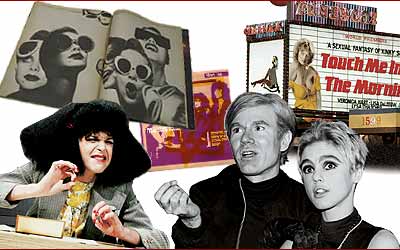
Every New Yorker is secretly (and in some cases, very openly) in love with some part of the city’s past. Pick your decade—it was better then. Well, pine no more: With our nostalgia guide, you can retrieve the Pop-hued sixties, the rocking seventies, the joyfully garish eighties, and the not-so-long-ago nineties. And if you need a role model, we’ve got four New Yorkers who love their era enough to live it every day.
The Sixties: Get Into Mod WorldThe Seventies: Adopt an Attitude of AnomieThe Eighties: Banish Thoughts of ModerationThe Nineties: Throw Everything Away
The Sixties: Get Into Mod World
A Day in the 60s
A little silver hair dye, a low-rise daybed, and the immortal words of Donovan are all it takes to get into mod world.
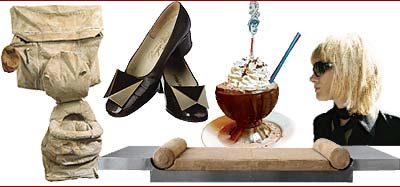
Sixties fashion was statement-making, so break with the present by starting your journey in the closet: A vinyl-trimmed dress and Roger Vivier patent-leather flats for you, and a form-fitting Pierre Cardin suit for your friend (Resurrection; 212-625-1374). Then head to Bumble and bumble, where Amy Farid will dye your hair (men’s and women’s) silver, and razor-trim it for an Andy- or Edie-esque shaggy cut (917-606-5000). Go for the full mod effect with a set of spidery false lashes and some pale lipstick from Shu Uemura (212-979-5500). Whet your Pop-acquisition appetite with a stroll through the retrospective of Claes Oldenburg’s early works at Zwirner & Wirth (212-517-8677). The crumpled toilet is probably beyond your budget, but there are still affordable artifacts. Sixties furniture hasn’t quite hit the insane price bracket yet, so be ahead of the craze and take home a low, streamlined daybed by Maria Pergay, whose designs have begun a rapid climb on the collector circuit (Demisch Danant; 212-989-5750). Curl up on your new purchase with Do You Sincerely Want to Be Rich?, the reissued history of master swindler Bernard Cornfeld, or delve into the trippy side of the sixties with the brand-new Autobiography of Donovan: The Hurdy Gurdy Man (Strand Book Store; 212-473-1452). If his tell-all gets you stressed, mellow out by strumming a few bars of “Jennifer Juniper” on your 1966 Martin D-18 (Main Drag Music; 718-388-6365). Got the munchies? Serendipity might be a catering hall for tourists and Upper East Side tweens now, but it was once the favorite eatery of Andy Warhol’s Factory cronies. Sit in the first alcove, where Warhol paid for his ice-cream sundaes with sketches of staffers (212-838-3531). Make sure to get tickets for the last screening of What’s Happening! The Beatles in the USA at MoMA on December 28 (212-708-9480). Start practicing now, so you can frug like a pro while the credits roll (Alee Reed at Pierre Dulaine Dance Club; 212-244-8400).
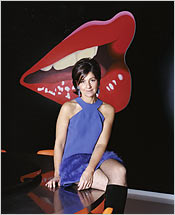
Living the Life
The Pop Lover
Lisa Perry fell hard for the sixties as a teenager; after a class trip to London and a life-changing visit to the trippy fashion emporium Biba, she redecorated her suburban bedroom in Op Art. Some 30 years later, Perry lives in the ultimate grown-up version of her teen fantasy—a gleaming, museum-quality temple to Pop on Sutton Place. “The sixties look makes me smile,” says Perry, who was born in 1958. She’s always worn the clothes; when she and her husband bought a penthouse in 2000, “I decided to do sixties world, and my husband said, ‘Let’s go all the way and do the art too,’ ” Perry says. (Their previous apartment was French Empire).
Over four years, with the help of an open checkbook and decorator Tony Ingrao, by power-browsing and buying online, Perry built a hyperconsistent world of artifacts and newer pieces. She scored twenty mint-condition Saarinen dining chairs at Machine Age in Boston for “half the amount I would pay for them in New York,” four Panton shell lamps and a Lucite bench by Charles Hollis Jones at R 20th Century in Tribeca, and dozens of “Marilyn” mugs from graveyardmall.com. The living room is lacquered white, the master bedroom is white vinyl, and white rugs cover the floor. There are Warhols, Lichtensteins, and Rosenquists everywhere, bought with the assistance of art consultant Dominique Lévy. “We were late getting into Pop by a couple years, but it was still decent,” she says. “Now you can’t touch the stuff.”
Perry’s style role model now is Audrey Hepburn circa How to Steal a Million; she’s mastered the teased bouffant (“I’m a nightmare in the rain”), and her pristine wardrobe includes a rare Paco Rabanne chain-link dress from Decades in Los Angeles and lots of Courrèges from Resurrection in New York. Friends have given her their mothers’ Puccis and Pierre Cardins. “One downfall of vintage is that seams split and buttons pop, so I am always equipped with a needle and thread,” she says. “At first I bought everything. Now I can wait for the really special pieces.” Top of her wish list: Yves Saint Laurent’s 1965 Mondrian dress. For that, “the sky would be the limit.”
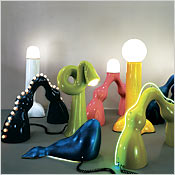
What’s Hot Now
Wendell Castle Lamps
It’s hard to beat the groove factor of Castle’s plastic floor “lamps”; they’re more like neon-trimmed solid-form Lava lamps than illumination tools. At $18,000 to $30,000, they aren’t exactly a steal; they are one of a kind, however, and their wild colors and emphatic style have them cued up as the next craze (R 20th Century Design; 212-343-7979).
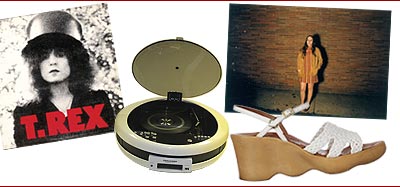
The Seventies: Adopt an Attitude of Anomie
A Day in the 70s
Old-school punk, dance-till-dawn decadence, and conceptual-art galleries that are actually still in Soho.
To really get a sense of the decade, take a day off and adopt an attitude of anomie; it’s the seventies, so you should be unemployed, anyway; half an hour with Rockstar Games’ new video game, The Warriors, will get you feeling good and alienated. For sonic fidelity, pick up a vintage Weltron turntable (Gimme Gimme Records; 212-475-2955) to spin the newly hip experimental disco of The World of Arthur Russell (Other Music; 212-477-8150), or listen to The Slider, just reissued from T. Rex. If you need more reminders of the era’s cultural richness, watch the brand-new DVD set God Save the Queen: A Punk Rock Anthology. Since you’ve got nothing but time, visit two survivors from Soho’s art-studio past: Walter de Maria’s Earth Room, which has withstood the malling of the neighborhood since 1977, and the Judd Foundation’s Conceptual installations at 101 Spring Street (212-219-2747 for an appointment). Refuel at Fanelli’s (212-226-9412) where artists used to eat when there was nothing else around. And since you’re only pretending to be scraping by, buy a work by iconic color-photography pioneer William Eggleston; some are still priced in the mid four-figures (Cheim & Read; 212-242-7727). As long as you’re spending money, primp a little bit in preparation for a night out. The big names of the seventies (Blass, Halston) have been picked over, but there are still treasures to be found, like the rare stash of pristine Famolare wave-patterned platforms, at Pegasus & Proper (718-782-2842). Codie at Hotel Venus (212-966-4066) does Debbie Harry’s hair, and she’ll flip yours into a Blondie-do, too. Opium, the scandalous fragrance whose druggy 1977 ad campaign touched off the first wave of heroin-chic hysteria, is still selling (Saks Fifth Avenue; 212-753-4000). Spray generously, to keep people out of your dancing space during AllDisco’s regular Saturday gig at Capone’s (718-599-4044). As the sun comes up on your way home, stop for an egg cream at Gem Spa on Second Avenue (212-995-1866), where the New York Dolls shot their first album cover.
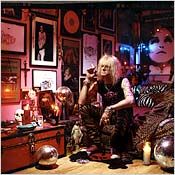
Living the Life
The Rocker
Last year, Jimmy Webb’s Christmas card was a photo of him and Steven Tyler hugging. “That’s punk rock,” Webb says. “The togetherness. The 48-year-old boy in tiger pants.” The boy got off the bus from upstate New York in 1974 and ran wild at Studio 54 and CBGB. Once, he asked Andy Warhol to sign a tab of acid. “It was one with the wizard-hat Mickey Mouse from Fantasia. I was like, ‘Holy shit!’ ”
Decades later, Webb’s look has barely changed (though his nightlife has gotten quieter). His entire wardrobe is from Agatha, from which he buys skinny leather pants—he just bought a $3,000 pair in silver with lightning bolts—and Trash and Vaudeville, where he works and gets his T-shirts and shoes: pink-and-white George Coxes, Converse high-tops, and glittery Creepers. He speaks softly, in a hybrid vocabulary that’s half-English, half-rock-ballad-verse. “The seventies were a big cry for love and acceptance, but there was freedom to be you,” he says. The punk-rock fuck-you of that era, as he calls it, has eroded, “but it will not disappear. I will always represent it.”
Webb’s windowless, subterranean lair is a shrine to his heroes. The ceiling is smeared in glitter; the walls are pink, “the ultimate punk color—the New York Dolls, man.” Green-and-pink strings of lights pay homage to the Sex Pistols’ Never Mind the Bollocks cover. The bedroom is wall-to-wall with photos of Steven Tyler, Sid Vicious, Mick Jagger, and especially Webb’s beloved Iggy Pop—he even has a photo-booth shot of his hero. Many of the pictures are originals by rock portraitists Mick Rock and Bob Gruen. (Rock has a Soho Grand show, but Webb missed the opening—“I was sprinkling pink stars on Iggy’s manager’s grave.”)
There are Farrah Fawcett candles, disco balls, an autographed Iron Maiden lunchbox, and Johnny Thunders’s old rosary—just talking about it makes Webb weep. “I’m saving up for a big Debbie Harry photo,” he says, standing beneath a JOEY RAMONE PLACE sign. “Every day, she’ll cover me with kisses, baby, cover me with love. It’s going to be awesome.”
—Denise Penny

What’s Hot Now
Paul Evans
In the late nineties, when the twentieth-century-furniture market was heating up, “you couldn’t give away Paul Evans furniture,” says James Zemaitis, director of Sotheby’s twentieth-century-design department. Now Evans’s Brutalist designs are heating up; in June, the auction house sold an armoire for $84,000, and one Evans piece recently went for over $100,000. He’s an acquired taste, though; “really, one piece is enough,” says Zemaitis. (Available at Phurniture; 212-575-2925.)
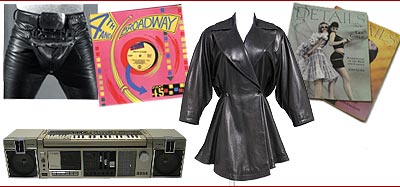
The Eighties: Banish Thoughts of Moderation
A Day in the 80s
Big hair, break dancing, and Bice: How to cram the Greed Decade’s trends into 24 hours.
Excess and exaggeration are the bywords of eighties culture, so banish any thoughts of moderation. Pump up your hair with a handful of Sebastian Shaper mousse (CVS; 646-602-8237). Then upholster your shoulders with a black leather Azzedine Alaia coat (Vintage Collections; 212-717-7702); add Alain Mikli sunglasses (212-751-6085) and a pair of bright-red, cone-heeled Charles Jourdan slingbacks (Cherry; 212-924-1410). Before you leave the house, catch Rick Springfield’s reprise as Dr.Noah Drake on General Hospital while ordering tickets for The Phantom of the Opera (212-239-6200), which started back in 1986 and is about to become the longest-running show on Broadway. With an outfit like that, you probably work in fashion, so lunch at Bice while reading the original, pre–Condé Nast Details (Gallagher’s Fashion Archive; 212-473-2404). Then cab it to Mary Boone’s Chelsea gallery to see eighties art star David Salle’s newest pomo paintings (212-752-2929), and consider buying one of Robert Mapplethorpe’s hard-core photos; the tough subject matter makes them more affordable (Sean Kelly Gallery; 212-239-1181). And don’t forget your aerobics! Tonight, it’s a popping-and-locking lesson with Rock Steady Crew member Pop Master Fabel (Steps on Broadway; 212-874-2410). Plenty of places still do fusioncuisine, but one of the best is the Biltmore Room (212-807-0111); now that you’ve felt the burn, tuck into giant prawns with honey-ginger vinaigrette and mango-mint salsa. Go home, preferably to an Upper East Side high-rise, for a little pre-party. Break out the you-know-what, and blast Eric B. & Rakim’s Paid in Full (Fat Beats; 212-673-3883). The East Village institution that is the Pyramid Club is still hosting Gay Eighties night on Fridays (212-228-4888). Prepare for the extended remix of “Borderline.” Or try Stereo, a new Chelsea club decorated with Walkmans and boom boxes (212-244-1965).

Living the Life
The Hip-Hopper
Claw Money grew up in Roslyn Harbor, Long Island, but she spent every possible moment of the eighties hanging out in downtown Manhattan—Danceteria, MK, Sticky Mike’s Frog Cafe—and perfecting her graffiti skills all over the city. Now 37, Claw (she doesn’t use, and won’t reveal, her real name) dresses like she’s lunching at Odeon with Maripol circa 1983—side ponytail, a single dangling earring, Stephen Sprouse fluorescent-yellow camouflage dress. Her career is in art and fashion (she’s featured in the graffiti documentary Infamy), but her passion is collecting artifacts from her youth.
“I love eighties fashion because it was so garish and so unapologetic,” she says. “To this day, my mom and sister think I’m a terrible dresser. They can’t believe I’m a fashion editor.” One of her favorite vintage stores is Red White and Blue in Paterson, New Jersey, where she once scooped up hundreds of Dior logo bags for about $5 each (and later sold them to Foley + Corinna and Resurrection).
Claw’s collections are specific to eighties New York, when the punk-rock and hip-hop scenes mixed freely. “Nobody is archiving this stuff, and it’s important. Why shouldn’t it be me?” she says. More than half of her 2,000 pairs of sunglasses are Cazals, “the old Jewish man in Miami glasses,” popularized by Run-DMC. She paid Cazals about $10,000 for its overstock. She scored 100 Norma Kamali designs at an estate sale in Morristown, New Jersey. Claw’s 25-plus boom-box collection includes Sharp’s VZ-2500, “a real Cadillac,” found for about $150 at the 26th Street flea market. She uses them to listen to cassettes of Stetsasonic and Flock of Seagulls, when she’s not rocking out on her Walkman, spongy earphones and all. “I never use my iPod. Ever.”
The pride of her 500-sneaker collection is a pair of $800 LL Cool J Troops. She even collects eighties spray paint, whose quality, she says, was far superior; colors like Hot Raspberry Enamel go for upwards of $400 on eBay. But she considers a Canal Street creation to be one of her most important pieces. Bought for $45, the bag is covered with the Pierre Cardin logo, stamped Dior on the inside, and closes with a Gucci pull chain. “It appropriates the status of three different labels,” says Claw, “turning it into this totally accessible streetwear. It is so specific to that one time in New York.”
—R.C.

What’s Hot Now
FJ40 Land Cruiser
The 1983 FJ40 Land Cruiser originally sold for $6,500. Today, it will set you back $35,000. Its cult status comes not just from its square-jawed looks and muscular engine, but, crucially, because there are so few of them: Under 250 were imported to the U.S., and it was the last year Land Cruisers were made. José Rivera, a mechanic, restorer, and dealer in East Orange, N.J., specializes in eighties Cruisers and only sells about a dozen a year (973-943-1705 for more info).
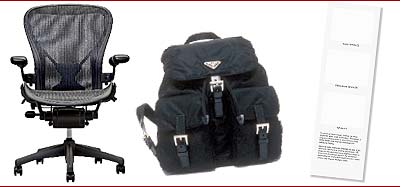
The Nineties: Throw Everything Away
A Day in the 90s
It’s never too early to start revisiting raves, minimalism, and online stock trading.
First, throw everything away: After all, the early nineties are when the minimalist lifestyle reigned supreme. Then, paint the walls Benjamin Moore Decorator’s White in matte (Janovic Plaza; 212-349-0001)—it’s a punishingly stark white. Go to the Two Jakes vintage-office-furniture store and pick up two Aeron chairs (718-782-7780) or a few Philippe Starck Costes chairs, for that height-of-the-Internet-gold-rush look. Complete it by getting a vintage orange iMac on eBay and turning it into a fishtank. Voilà! Your apartment is furnished. Now begin a strictfitness regime. Get a pair of Rollerblades at Paragon (212-255-8036), wear them over Donna Karan leggings, and start lapping Central Park at 7am. When you get back, open an account with Charles Schwab. After a few NASDAQ trades, put your work look together with a razor-sharp black vintage Helmut Lang suit (try Tokyo Joe; 212-473-0724), and a black nylon Prada backpack (212-334-8888) for that sporty tech look. Then ask Kevin Lee at Kenneth Salon (212-752-1800) to layer your hair and blow it stick-straight, just like Rachel Green in the first season of Friends. Refuel with a martini and the seafood salad at Gotham Bar & Grill (212-620-4020), still incredibly popular with the power-lunch crowd. For dinner, remind yourself that Japanese cuisine used to be exotic by ordering the black cod miso at Nobu Next Door. It’s the go-go nineties, so don’t go to bed yet! Buy a grande espresso at the Starbucks on Astor Place before taking a cab out to Dumbo for the rave at Lunatarium (lunatarium.com), which really starts to crank around 2 a.m. When you get back, gorge on SnackWells’ Fat Free Devil’s Food Cakes while watching the newly released Seinfeld: Seasons 5 and 6. Then blast Nirvana’s Sliver: The Best of the Box, and light a candle for Kurt.
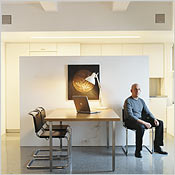
Living the Life
The Minimalist
In 1991, Belmont Freeman turned 40 and started paring down his life. He ended a long-term relationship, sold off most of his books and art, and cleaned out his closets. His one addition—and it was major—was a Riverside Drive penthouse that he gut-renovated in 2000 as a minimalist mission statement for his architectural practice. “Life can be better with less,” says Freeman, who shaves his head to avoid dealing with hair upkeep. “Living this way makes me feel clean.”
Freeman limited himself to four building materials—white plaster walls, white lacquered-wood cabinetry, stainless steel, and blue-gray terrazzo floors (no rugs). The few furnishings are strictly black, gray, or light wood. Of the one small sofa, a George Nelson daybed, he says: “I can only sit in one place at a time.”
His favorite appliances are appropriately invisible: The Miele G843 dishwasher has controls on the inside and is fronted with the same white Formica as the kitchen cabinets; likewise the Sub-Zero 700 Series. “People walk into my kitchen and have no idea where the refrigerator is,” he says. Decoration is limited to a $20 mud cloth from Mali and a Jim Dine lithograph. He has other things in storage, but, he says, “I don’t need to display every book I’ve read to prove my credentials as a literate human being.”
Needless to say, Freeman isn’t exactly stoking the economy; mostly he buys food. His few CDs—hidden in a built-in drawer—are minimalists Philip Glass, Steve Reich, and La Monte Young. His wardrobe comes almost entirely from Barneys New York, and consists of Yohji Yamamoto, Issey Miyake, and especially Jil Sander, whose iconic techno suit he cherishes. He tries not to look at postmodernist “atrocities” like Philip Johnson’s AT&T Building.
Living in a cluttered world takes discipline for someone who values, above all, open space. Freeman opens mail the day it arrives, answers correspondence immediately to avoid “psychological clutter,” and limits the duration of visits to his sister’s “filled-with-things” house. “The world would be a much better place if people came to their senses and realized they don’t need to live such acquisitive lives,” he explains.
—R.C.
What’s Hot Now
Visionaire, Issue 1
Unapologetically expensive (the charter subscription was $60), intermittently published, and awash in concept, the ultra-artsy Visionaire called itself “a couture version of a magazine” and treated fashion and style with serious reverence. Each edition was assigned a theme (the Bible, black, erotica) and overseen by a “curator” (Tom Ford, Karl Lagerfeld) who mustered the images. By limiting its printing to under 1,000 copies and working with top artists, photographers, and illustrators, Visionaire made itself an object of desire. Visionaire is now up to issue 47, and some back issues are available through its office here (212-274-8959), but issues one (April 1991) through four are highly prized and sometimes available on that most nineties of marketplaces, eBay.
Additional reporting by Denise Penny, Yael Kohen, and Sarah Bernard.